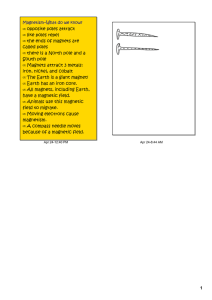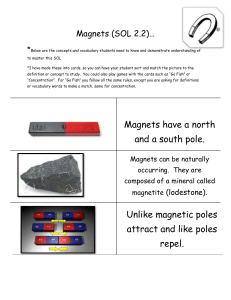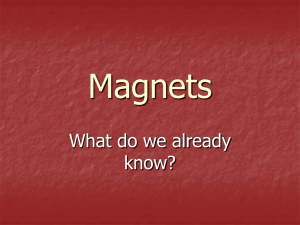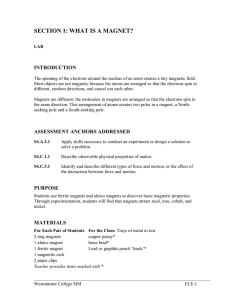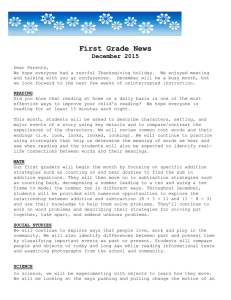Attract and Repel Grade 2
advertisement
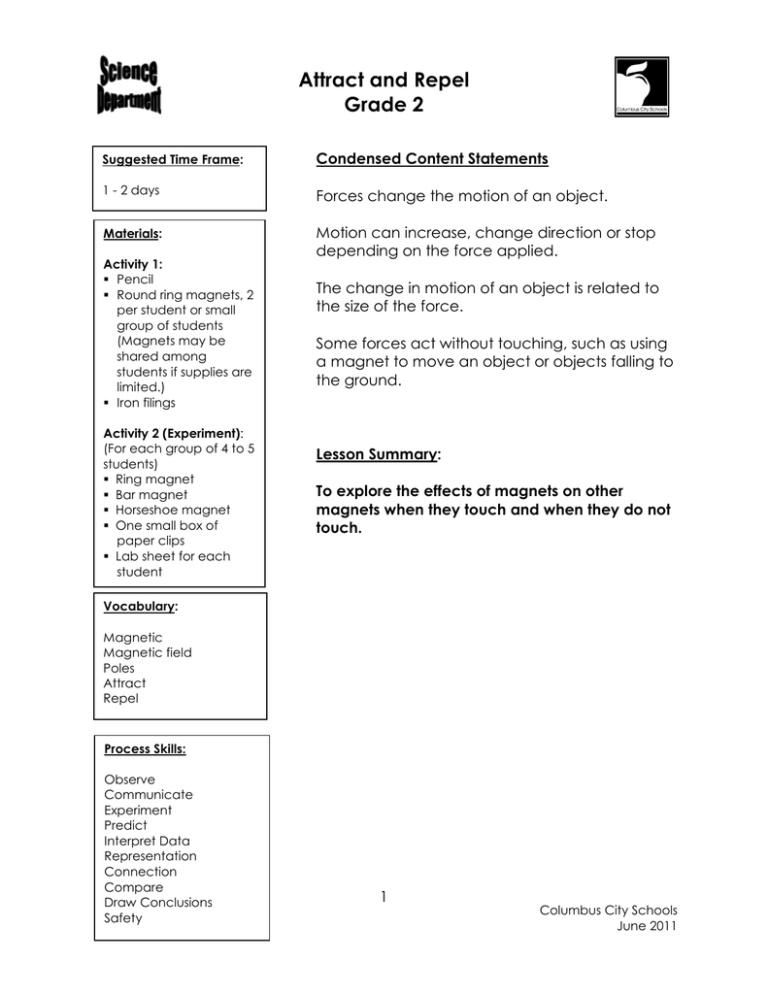
Attract and Repel Grade 2 Suggested Time Frame: Condensed Content Statements 1 - 2 days Forces change the motion of an object. Materials: Motion can increase, change direction or stop depending on the force applied. Activity 1: Pencil Round ring magnets, 2 per student or small group of students (Magnets may be shared among students if supplies are limited.) Iron filings Activity 2 (Experiment): (For each group of 4 to 5 students) Ring magnet Bar magnet Horseshoe magnet One small box of paper clips Lab sheet for each student The change in motion of an object is related to the size of the force. Some forces act without touching, such as using a magnet to move an object or objects falling to the ground. Lesson Summary: To explore the effects of magnets on other magnets when they touch and when they do not touch. Vocabulary: Magnetic Magnetic field Poles Attract Repel Process Skills: Observe Communicate Experiment Predict Interpret Data Representation Connection Compare Draw Conclusions Safety 1 Columbus City Schools June 2011 Attract and Repel Grade 2 Teacher Background Some materials are magnetic and some are not. Magnets are rocks or metals that have the power to attract materials made of certain metals such as iron and steel. Magnets have two ends called poles: north pole and south pole. Like poles repel or push away from each other and unlike poles attract or pull toward each other. Attraction and repulsion are magnetic forces. A magnetic field surrounds every magnet, creating a pattern around and between its poles. The earth itself has a large magnetic field. Its magnetic poles are located near the North and South poles. There are many different types of magnets that serve a variety of purposes. Bar magnets are used in compasses (needles) and also in door latches. The earth acts like a giant bar magnet. Horseshoe magnets are curved bar magnets that are used in small motors. Circular magnets do not have poles; instead the magnetism runs in a circle. However, circular magnets do attract and repel each other. They are used in large compasses. Disk magnets have one pole around the edge and the other in the center. They are used in speakers. Electromagnets are used in telephones and doorbells. Teacher Notes This lesson includes two activities. In the first activity, students will explore the poles of circular magnets and discover which poles attract and which poles repel. In the second activity, students will test the strength of different types of magnets and graph the results. Engage (Warm-up) 1. Demonstrate the use of magnets by using iron filings (can be purchased at a teacher supply store). 2. Inform students that they will be exploring magnets and how they are used. Explore (Instructional Strategies) Activity 1 1. Discuss safe use of magnets with the class. (Magnets should be handled carefully. If they are banged against the table or broken they lose their magnetic force. They should not be used near computers.) Give each student or group of students two ring magnets and a pencil. Allow students time to experiment and make observations with the magnets. 2 Columbus City Schools June 2011 Attract and Repel Grade 2 2. Instruct students to hold the pencil vertically and put both magnets on the pencil in a touching position (attraction). Then have students position magnets on the pencil in a nontouching position (repulsion). One magnet may appear to float! Discuss student observations. Identify the poles of the magnets as North and South. Explain that like poles repel each other and unlike poles attract each other. 3. Do this same activity with other magnets on the table, moving them slowly toward each other, observing whether the poles near each other are the same (magnets will repel) or different (magnets will attract). Activity 2 1. Provide each group of students with the experiment materials (ring magnet, bar magnet, horseshoe magnet and paper clips). Explain that, in using the materials, students will test the strength of different types of magnets. 2. Instruct students to use each magnet to pick up a pile of paper clips. Discuss with students how to conduct a fair test (place same number of clips in pile each time, place magnet the same height above the paperclip pile, move magnet up and away from paperclip pile, pull paper clips from magnet and count). 3. Students should predict which magnet will pick up the most paper clips. 4. As each group tests each type of magnet, they should record the number of paper clips picked up on the lab sheet in the chart. After testing all three magnets, the information from the chart should then be used to complete the graph at the bottom of the page. Groups should share their data and compare to the results of the other groups. 5. As an additional activity, the students could develop more questions to test with the magnets. (Students may want to see what happens when a wet magnet is used to conduct the same experiment; What happens when different materials are placed between the test magnet and the paperclip pile?; What happens when different sizes of magnets are used?; What happens when several magnets are stacked together?) This is a good time to review which questions are testable and which are not. Assessment 1. What happened to the magnets on the pencil when opposite poles were facing each other? (Opposite poles attract, or pull, so the magnets were together.) 2. What happened to the magnets on the pencils when like poles were facing each other? (Poles that are like repel, or push away from, each other.) 3. During the experiment, which magnet did you predict would pick up the most paper clips? Was your prediction correct? 4. What did you do during the experiment to make it a fair test? (Used the same number of paper clips each time, placed the magnets at the same place to pick up the paper clips). 3 Columbus City Schools June 2011 Attract and Repel Grade 2 5. How do non-touching magnets affect each other? (They push away or against each other.) Reteach Ideas 1. Use the UnitedStreaming video: A First Look at Magnets to reinforce how magnets are used. 2. The video allows time for discussion between segments. Closure 1. Have students complete the “Magnet Review” sheet. Extensions/Additional Resources Classroom Portals/Technology: UnitedStreaming: A First Look at Magnets (All Segments) Literature: What makes a Magnet by Franklyn Branley Magnets by Karen Bryant-Mole 4 Columbus City Schools June 2011
